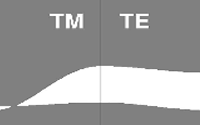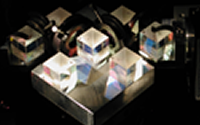James Franck Institute,
929 E 57th Street, Chicago, IL 60637
wtmirvine [at] uchicago.edu

| William Irvine James Franck Institute, 929 E 57th Street, Chicago, IL 60637 wtmirvine [at] uchicago.edu |
 |
|||||
| Research | Publications | CV | Collaborators and Links | Home | ||
Recent |
|
Topological defects in curved space |
|
|
When a two-dimensional crystalline lattice is draped onto surface that has non-zero Gaussian curvature, its orientational order is frustrated by the non-Euclidean geometry that applies on the curved surface. This leads to the generation of non-local stress distributions in the lattice.which in turn can affect the generation and dynamics of topological defects.
We have used a system of PMMA micron sized spheres bound to curved oil-water interfaces to investigate these phenomena on surfcaes of positive, negative, spatially-and-time-varying gaussian curvature. In addition to imaging the particles with a confocal microscope, we simultaneously manipulated them using holographic tweezers whose operation is independent of the confocal imaging. |
Topological tweezers |
|
We study the behaviour of a two-dimensional lattice of colloids in an applied optical potential, shaped using holographic techniques. The potential is designed to act collectively on many particles, `pulling' on each particle with a force that does not exceed that exerted by neighbouring particles. We have demonstrated how such a potential can be used as a 'topological tweezer' applied non-locally to produce, grab and position a topological defect. We have further used it to study defect kinetics and reactions.The potential can further be tailored to study a variety of problems which can be broadly classified by the order of the applied potential, for example periodic, quasiperiodic and random. |
|
Electromagnetic knots |
|
Maxwell's equations allow for remarkable solutions with complex field line geometry, characterized by the degree of linking and knottedness of the electric and magnetic field lines. A striking example is a solution in which all electric(magnetic) field lines are circles with any two electric(magnetic) linked to each other, a configuration known as the Hopf fibration. The structure and evolution of these fields is governed entirely by geometry. Beyond the study of such structures in light we are looking at realizations of knotted fields in `softer' phases. |
|
Lock and key colloids |
|
Lock and key binding (quicktime) |
The design of colloidal scale building blocks capable of self-assembling into functional meta-materials is an appealing goal that has the potential to revolutionize the production of smart materials.
We demonstrated a `lock-and-key' recognition mechanicsm between colloidal particles that is based on their complementary geometry. Using a combination of specially designed colloids that have complementary shape and depletion as an interaction, we observed reverible and flexible assembly of colloidal molecules and polymers. |
Past (Ph.D) research |
|
Single photons in nonlinear photonic crystals |
|
 |
The conversion of light fields from one frequency to another can be mediated by materials with a nonlinear optical response. In such materials the light field polarizes the atomic orbitals beyond the linear regime to excite oscillations at higher frequencies. This typically requires high electric fields. Single photons, by contrast have small electric field strength. We have proposed schemes to achieve nonlinear interactions involving few photons in a semiconductor (GaAs). The basis for the proposed experiments is the interplay between the high intrinsic nonlinear response of GaAs and interference effects which arise when light propagates through wavelength-scale structures which can be realistically fabricated out of GaAs. A favourbale setting for the realization of such an interaction is provided by defect cavities in photonic quasicrystals.
|
Hardy's thought experiment, quantum cloning and Bell's inequalities |
|
 |
One of the great achievements in the physics of the last half century, is the formulation of Bell's inequalities and their partial experimental verification. Bell's inequalities create a testable and concrete contradiction between some counter-intuitive predictions of quantum mechanics and the predictions of local-hidden variable theories, based on the notion that quantum meeasurements reveal pre-existing values. . We demonstrated the first experimental realization of Hardy's thought experiment, sometimes referred to `the best version of bells' theorem' Using photons. With similar technology, we carried out a poorman's relization of quantum cloning experiment. Finally, we proposed a scheme for a realistic implementation of a final test of Bell's inequalities. |